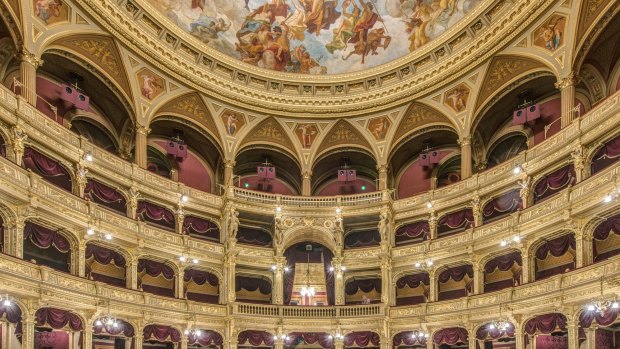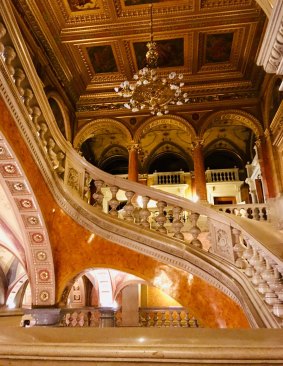This was published 4 years ago
Black Sea to Budapest cruise: A glimpse into Budapest's high society
By Kristi Kellahan

Hungarian State Opera House Credit: Getty Images
At the top of the grand red-carpeted staircase that connects the ground and first floors of the Hungarian State Opera House, an ornate, framed mirror has witnessed the comings and goings of Budapest's high society for more than 135 years. Reaching almost to the high, domed ceiling, it's vast and weighty, though it is said to have the opposite illusory effect on those who peer into it and back at themselves.
Queen Sisi of Hungary, a regular opera-goer in the 1880s, reportedly loved swanning past the mirror on her way into the theatre, for one very relatable reason: She believed it made her look thinner.
I ask our tour guide Istvan if it really has that effect. "You be the judge," he says.

The ornate staircase inside the Hungarian State Opera House.
"After a week of cruising? Forget it," says one of my fellow passengers, an attractive Texan woman.
We've reached Budapest after eight nights aboard the Avalon Illumination, cruising on Avalon Waterways' Black Sea to Budapest voyage. The visit to the opera house is first stop on an optional shore excursion to three of the city's Belle Époque Art and Architecture gems. Closed to the public until 2021 for an extensive restoration, it's only possible to sneak a peek inside the neo-Renaissance masterpiece building on organised tours.
Designed by architect Miklós Ybl, the opera house was unveiled in 1884 at the height of Europe's giddy Belle Époque. Legend has it that Emperor Franz Josef I was upset on opening night because the building's beauty overshadowed that of his beloved opera house in Vienna.
When the famed company is in season, tickets can be bought for less than $10. The stage can't really be seen from those seats, but the music can be heard, making them a favourite with students. The most expensive box seats go for around $125, a steal according to one passenger from the Hunter Valley, who pointed out she paid more than that for tickets to Muriel's Wedding, the musical.
Budapest in the final decade-and-a-half of the 19th Century was a gilded wonderland of opulence and prosperity. Long before the devastation that would be wreaked by two world wars, a global financial crisis and an oppressive socialist regime, the city optimistically flourished in every way.
The reminders of that glorious past are most visible along Andrássy Avenue, the Champs-Élysées of Budapest. Mansions that once housed wealthy merchants and their broods are now home to handbag shops and artisanal ice-creameries. Diagonally opposite the opera house on the avenue, the upscale Muvész cafe has been serving decadent desserts and drinks since 1898. We stop by for refreshments and an intoxicating choice of sweet treats, displayed in revolving glass cases like edible treasures. I pick the lemon meringue tart, while others devour strawberry mousse gateau, hazelnut torte, apple crumble and gluten-free chocolate pots.
Fortified, I hop back on the bus and head to the third and final stop on the tour. The Miksa Róth Memorial House celebrates Róth, the phenomenally talented glass-painter and ceramicist known as the Hungarian Tiffany. By the late 1800s, at the height of his success, Róth had been commissioned to create Art Nouveau stained-glass windows for Budapest's wealthiest families and grandest buildings, including the Parliament and Gresham Palace. Many of his original works are on display. Many more were destroyed during the dark days of World War 2.
The specialty museum is tastefully curated in what was Róth's workshop and family home in the heart of the Jewish Quarter. Faded photographs of his wife and three children stare back at me as I walk through the rooms where they once lived and laughed.
By 1944, Róth was dead, consumed by worry as anti-Semitism spread like a summer bushfire throughout Europe. He had converted to Roman Catholicism years earlier to marry his wife, but feared his Jewish heritage and connections would make him a target.
"He feared that everything he had succeeded in would be lost," our guide tells us.
It wasn't. The beauty of his art has survived, and we are here to witness it.
TRIP NOTES
Kristie Kellahan travelled in Hungary as a guest of Avalon Waterways.
MORE
CRUISE
Avalon Waterways' 11-night cruise, The Danube from the Black Sea to Budapest, is scheduled for monthly departures from April to October in 2020. Belle Époque Art & Architecture of Budapest is an optional shore excursion.
FLY
Qatar Airways flies from Sydney and Melbourne to Budapest via Doha. See qatarairways.com.
STAY
InterContinental Budapest's prime location on the riverbank promenade ensures guests with waterfront-facing suites enjoy unbeatable views of the Royal Palace and mega-fireworks displays in the summertime.
See ihg.com.
Sign up for the Traveller Deals newsletter
Get exclusive travel deals delivered straight to your inbox. Sign up now.